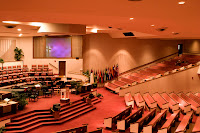 Choosing a projector can be very confusing as you look through hundreds of pages of specifications and spend hours on the internet looking for the right machine. In this blog, we'll talk about LCD and DLP projectors and the main differences between the two technologies.
Choosing a projector can be very confusing as you look through hundreds of pages of specifications and spend hours on the internet looking for the right machine. In this blog, we'll talk about LCD and DLP projectors and the main differences between the two technologies.First, let's look at LCD technology. Liquid Crystal Display (LCD) technology has been around longer than DLP and, as a result is said to have a more mature market. LCD technology splits the light coming from the source into three separate paths: one for each of the red, green ,and blue primary colors. As the light passes through the LCD glass panels, individual pixels can be turned on or off, creating the desired color image. The lights paths are then combined and passed through the lens and onto the screen.
Digital Light Processing (DLP) technology was invented in 1991 by Texas Instruments and is based on an optical semiconductor called a digital micromirror device, or DMD. DLP projectors come in two varieties, single and three-chip models. Typically, three-chip models are only found in high-end applications with starting prices over $10,000. The DMD acts as a light switch using mirrors to direct light towards or away from a dedicated pixel space. A color wheel is used in single-chip models that synchronizes with the mirrors to provide color to the image. The light is reflected from the mirrors and passes through the lens and onto the screen. Three-chip projectors use individual chips for each of the red. green, and blue colors and use filters and steering mirrors to create the color images on the screen.
While both projectors have advantages and disadvantages, there really is no hard and fast rule for choosing which technology to use. In most cases, cost will likely be the deciding factor, but you should understand the major advantages and disadvantages of each technology.
The biggest advantage with LCD projectors is that they produce sharper, more natural-looking color images. Some have said that LCD machines are brighter, but I think that they are more correctly stated as being more efficient than DLP machines, since the light path is straight and not reflected. Colors are more closely reproduced and computer images appear to have sharper, more defined edges. Images that are displayed in rooms with larger amounts of ambient light will appear brighter on LCD projectors. The main disadvantage with LCD technology is that moving images, such as video, will appear pixelated. This has gotten better since the evolution of 3LCD, or 3-chip machines, but it is still more noticeable on LCD than on DLP projectors. LCD projectors have traditionally been physically larger than comparable DLP projectors, but this is rapidly changing as well. Another disadvantage, though it really is more of an advantage for DLP, is that blacks will usually appear gray on the screen. This is because LCD projectors have less contrast than DLP projectors.
The biggest advantage of DLP projectors is that video images appear very smooth and black images maintain more detail. At this point, I need to remind you that black detail is going to be determined by the contrast ratio, as we discussed in the last blog, however, black images do appear to be darker and more film-like on DLP projectors. The main disadvantage of DLP projectors is that color reproduction is not as good as LCD technology. Yellows and reds tend to appear washed out and require compensation, which is possible, but at the expense of brightness. Typically, DLP projectors will require more lumens to produce bright, colorful images in rooms with moderate to large amounts of ambient light.
So what do we do with all this information? Remember the three questions we used in the last blog?
- What's the budget?
- What's the purpose?
- Where's it going?
Don't be afraid to get opinions, but don't froget to do your homework. Remember, if you take the time to do your research, you will have no problem choosing the right projector.




